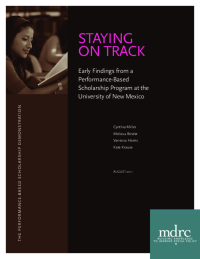Staying on Track
Early Findings from a Performance-Based Scholarship Program at the University of New Mexico
Although a growing number of individuals are enrolling in college in response to the increasing payoff to higher education, more than a third of them never finish. College completion rates are especially disappointing for low-income students, in many cases because they tend to enter college underprepared academically but also because they have more difficulty covering the costs of attendance. This report presents early results from a program at the University of New Mexico (UNM) that increases the financial support available to low-income entering students who enroll for a minimum number of credits and maintain a minimum grade point average. The program, called VISTA (Vision Inspired Scholarship Through Academic Achievement), is one of nine scholarship programs being tested across the country as part of the national Performance-Based Scholarship Demonstration. The demonstration is testing several types of performance-based scholarships in order to identify promising strategies to increase college persistence and completion among low-income students.
VISTA provides low-income entering freshmen with up to $1,000 in financial aid per semester for four semesters, in addition to any standard financial aid they receive. The funds are paid directly to the student in three installments each semester and are conditional on full-time enrollment and a "C" or better average. VISTA also provides students with enhanced academic advising, requiring them to meet at least twice during the semester with a designated VISTA advisor.
The effects of VISTA are being assessed using a randomized control trial, in which over 1,000 low-income students who entered UNM in the fall of 2008 and the fall of 2009 were assigned at random to either the VISTA group, whose members are eligible for the program, or a control group, whose members are eligible only for standard financial aid and counseling. The evaluation is tracking these students’ college performance for four years — that is, during the two years (four semesters) of the program and for two years after the scholarship ends. Early findings, through one year, indicate that although VISTA had no effects on credits or grades during the first semester, effects did emerge after that point:
- VISTA encouraged students to attempt and earn more credits. Students in the VISTA group were substantially more likely than those in the control group to attempt 15 or more credits in the second semester, the minimum needed for VISTA. As a result, they were 8.8 percentage points more likely to have earned 30 or more credits by the end of their first year, increasing the likelihood that they would be on track for an on-time graduation.
- VISTA led to a net increase in financial aid dollars and allowed some students to reduce their reliance on loans. Students in the VISTA group received, on average, $900 more in aid than those in the control group, and were about 6 percentage points less likely to have loans.
- Although VISTA did not affect overall enrollment rates for the third semester, it did result in students registering for more credits. About 78 percent of students in the study returned to UNM to register for classes in their third semester. Enrollment rates were similar for students in both the VISTA and control groups. However, VISTA students were much more likely to have enrolled for at least 15 credits.
A final report on VISTA will be published in 2014.






